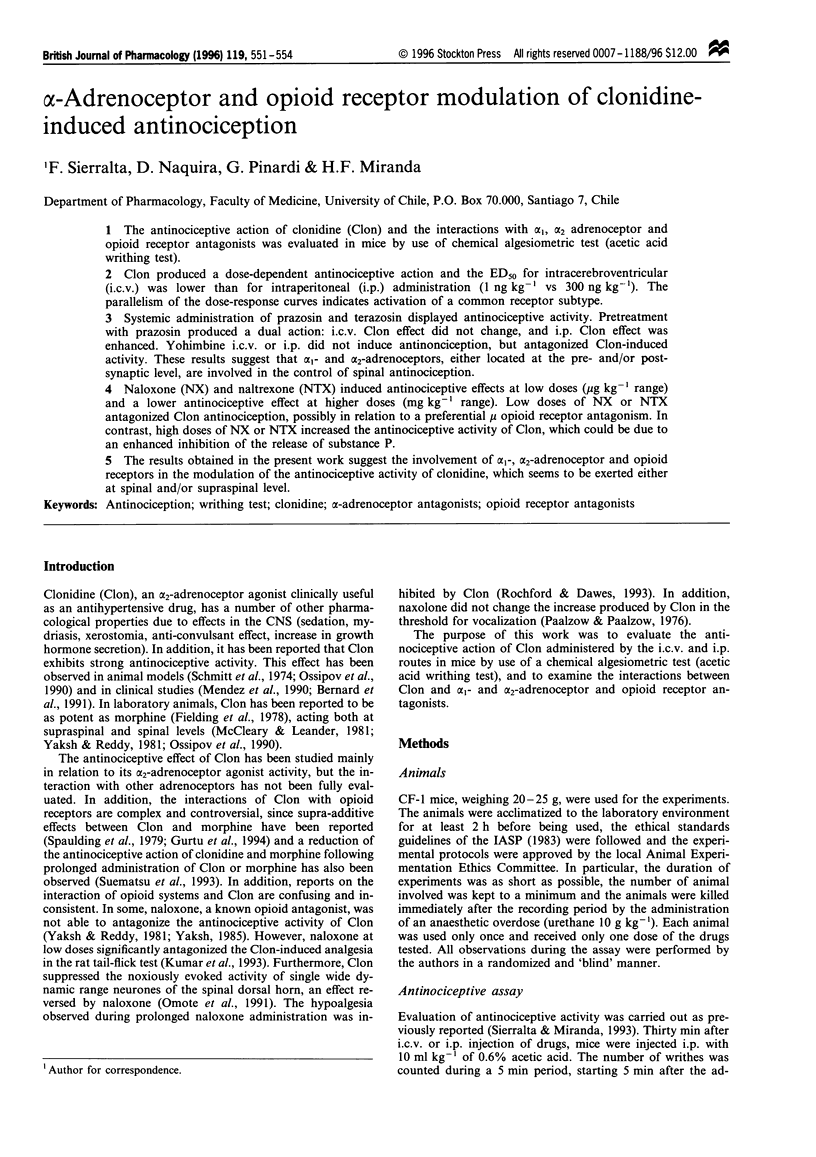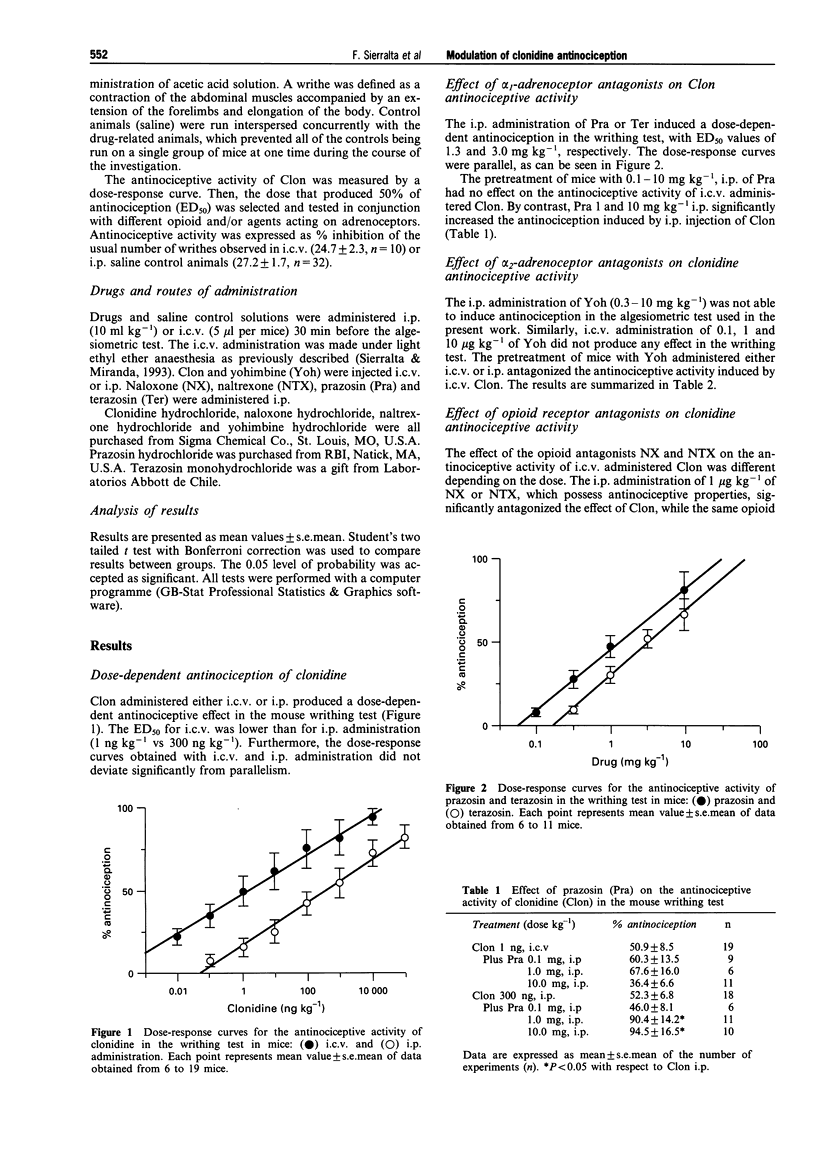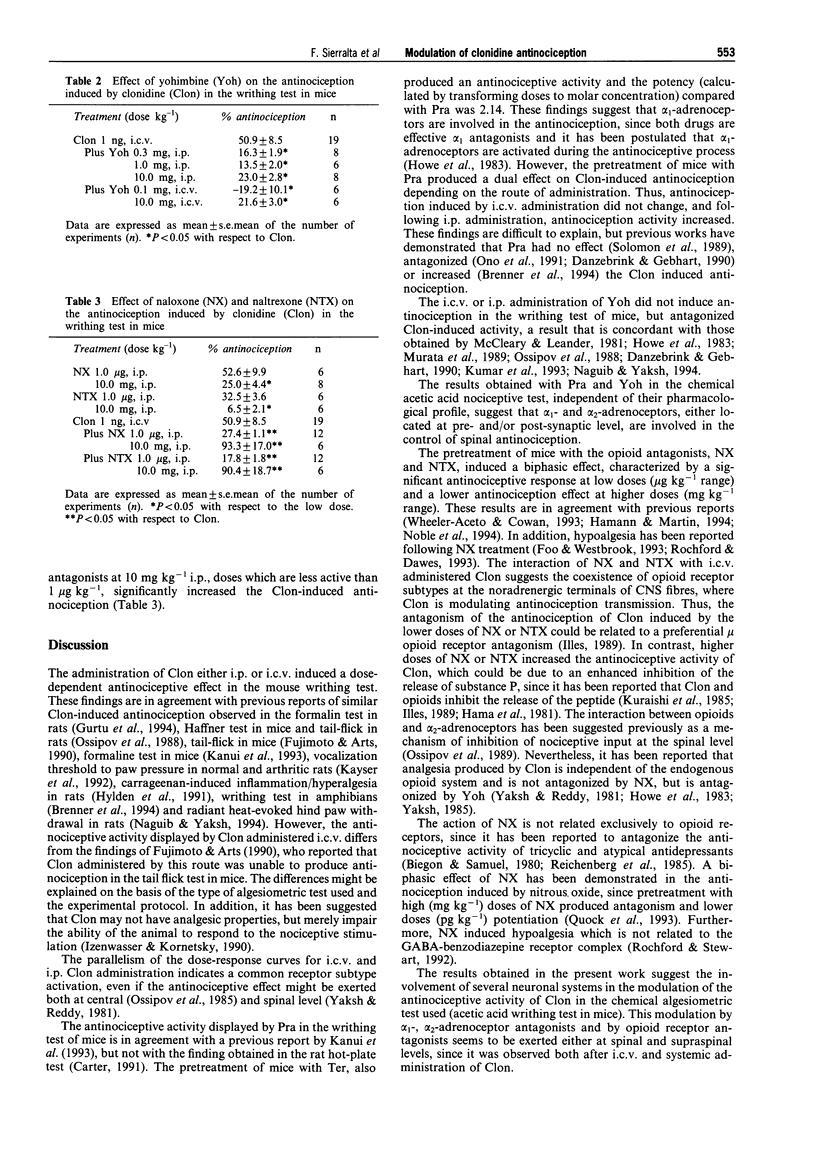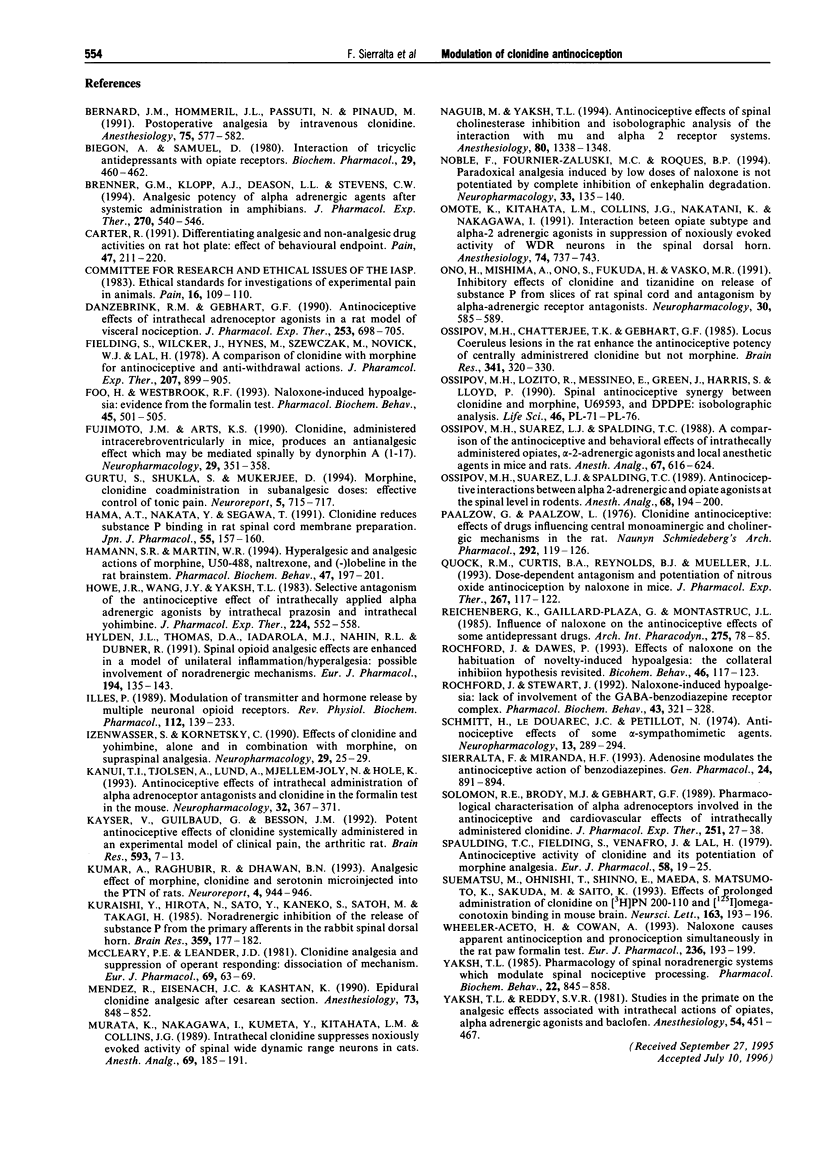Abstract
1. The antinociceptive action of clonidine (Clon) and the interactions with alpha 1, alpha 2 adrenoceptor and opioid receptor antagonists was evaluated in mice by use of chemical algesiometric test (acetic acid writhing test). 2. Clon produced a dose-dependent antinociceptive action and the ED50 for intracerebroventricular (i.c.v.) was lower than for intraperitoneal (i.p.) administration (1 ng kg-1 vs 300 ng kg-1). The parallelism of the dose-response curves indicates activation of a common receptor subtype. 3. Systemic administration of prazosin and terazosin displayed antinociceptive activity. Pretreatment with prazosin produced a dual action: i.c.v. Clon effect did not change, and i.p. Clon effect was enhanced. Yohimbine i.c.v. or i.p. did not induce antinonciception, but antagonized Clon-induced activity. These results suggest that alpha 1- and alpha 2-adrenoceptors, either located at the pre- and/or post-synaptic level, are involved in the control of spinal antinociception. 4. Naloxone (NX) and naltrexone (NTX) induced antinociceptive effects at low doses (microgram kg-1 range) and a lower antinociceptive effect at higher doses (mg kg-1 range). Low doses of NX or NTX antagonized Clon antinociception, possibly in relation to a preferential mu opioid receptor antagonism. In contrast, high doses of NX or NTX increased the antinociceptive activity of Clon, which could be due to an enhanced inhibition of the release of substance P. 5. The results obtained in the present work suggest the involvement of alpha 1-, alpha 2-adrenoceptor and opioid receptors in the modulation of the antinociceptive activity of clonidine, which seems to be exerted either at spinal and/or supraspinal level.
Full text
PDF



Selected References
These references are in PubMed. This may not be the complete list of references from this article.
- Bernard J. M., Hommeril J. L., Passuti N., Pinaud M. Postoperative analgesia by intravenous clonidine. Anesthesiology. 1991 Oct;75(4):577–582. doi: 10.1097/00000542-199110000-00006. [DOI] [PubMed] [Google Scholar]
- Biegon A., Samuel D. Interaction of tricyclic antidepressants with opiate receptors. Biochem Pharmacol. 1980 Feb;29(3):460–462. doi: 10.1016/0006-2952(80)90531-6. [DOI] [PubMed] [Google Scholar]
- Brenner G. M., Klopp A. J., Deason L. L., Stevens C. W. Analgesic potency of alpha adrenergic agents after systemic administration in amphibians. J Pharmacol Exp Ther. 1994 Aug;270(2):540–545. [PubMed] [Google Scholar]
- Carter R. B. Differentiating analgesic and non-analgesic drug activities on rat hot plate: effect of behavioral endpoint. Pain. 1991 Nov;47(2):211–220. doi: 10.1016/0304-3959(91)90207-E. [DOI] [PubMed] [Google Scholar]
- Danzebrink R. M., Gebhart G. F. Antinociceptive effects of intrathecal adrenoceptor agonists in a rat model of visceral nociception. J Pharmacol Exp Ther. 1990 May;253(2):698–705. [PubMed] [Google Scholar]
- Fielding S., Wilker J., Hynes M., Szewczak M., Novick W. J., Jr, Lal H. A comparison of clonidine with morphine for antinociceptive and antiwithdrawal actions. J Pharmacol Exp Ther. 1978 Dec;207(3):899–905. [PubMed] [Google Scholar]
- Foo H., Westbrook R. F. Naloxone-induced hypoalgesia: evidence from the formalin test. Pharmacol Biochem Behav. 1993 Jun;45(2):501–505. doi: 10.1016/0091-3057(93)90271-t. [DOI] [PubMed] [Google Scholar]
- Fujimoto J. M., Arts K. S. Clonidine, administered intracerebroventricularly in mice, produces an anti-analgesic effect which may be mediated spinally by dynorphin A (1-17). Neuropharmacology. 1990 Apr;29(4):351–358. doi: 10.1016/0028-3908(90)90093-7. [DOI] [PubMed] [Google Scholar]
- Gurtu S., Shukla S., Mukerjee D. Morphine, clonidine coadministration in subanalgesic doses: effective control of tonic pain. Neuroreport. 1994 Feb 24;5(6):715–717. doi: 10.1097/00001756-199402000-00014. [DOI] [PubMed] [Google Scholar]
- Hama A. T., Nakata Y., Segawa T. Clonidine reduces substance P binding in rat spinal cord membrane preparation. Jpn J Pharmacol. 1991 Jan;55(1):157–160. doi: 10.1254/jjp.55.157. [DOI] [PubMed] [Google Scholar]
- Hamann S. R., Martin W. R. Hyperalgesic and analgesic actions of morphine, U50-488, naltrexone, and (-)-lobeline in the rat brainstem. Pharmacol Biochem Behav. 1994 Jan;47(1):197–201. doi: 10.1016/0091-3057(94)90131-7. [DOI] [PubMed] [Google Scholar]
- Howe J. R., Wang J. Y., Yaksh T. L. Selective antagonism of the antinociceptive effect of intrathecally applied alpha adrenergic agonists by intrathecal prazosin and intrathecal yohimbine. J Pharmacol Exp Ther. 1983 Mar;224(3):552–558. [PubMed] [Google Scholar]
- Hylden J. L., Thomas D. A., Iadarola M. J., Nahin R. L., Dubner R. Spinal opioid analgesic effects are enhanced in a model of unilateral inflammation/hyperalgesia: possible involvement of noradrenergic mechanisms. Eur J Pharmacol. 1991 Mar 5;194(2-3):135–143. doi: 10.1016/0014-2999(91)90097-a. [DOI] [PubMed] [Google Scholar]
- Illes P. Modulation of transmitter and hormone release by multiple neuronal opioid receptors. Rev Physiol Biochem Pharmacol. 1989;112:139–233. doi: 10.1007/BFb0027497. [DOI] [PubMed] [Google Scholar]
- Izenwasser S., Kornetsky C. Effects of clonidine and yohimbine, alone and in combination with morphine, on supraspinal analgesia. Neuropharmacology. 1990 Jan;29(1):25–29. doi: 10.1016/0028-3908(90)90079-7. [DOI] [PubMed] [Google Scholar]
- Kanui T. I., Tjølsen A., Lund A., Mjellem-Joly N., Hole K. Antinociceptive effects of intrathecal administration of alpha-adrenoceptor antagonists and clonidine in the formalin test in the mouse. Neuropharmacology. 1993 Apr;32(4):367–371. doi: 10.1016/0028-3908(93)90158-y. [DOI] [PubMed] [Google Scholar]
- Kayser V., Guilbaud G., Besson J. M. Potent antinociceptive effects of clonidine systemically administered in an experimental model of clinical pain, the arthritic rat. Brain Res. 1992 Oct 9;593(1):7–13. doi: 10.1016/0006-8993(92)91255-d. [DOI] [PubMed] [Google Scholar]
- Kumar A., Raghubir R., Dhawan B. N. Analgesic effect of morphine, clonidine and serotonin microinjected into the PTN of rats. Neuroreport. 1993 Jul;4(7):944–946. doi: 10.1097/00001756-199307000-00027. [DOI] [PubMed] [Google Scholar]
- Kuraishi Y., Hirota N., Sato Y., Kaneko S., Satoh M., Takagi H. Noradrenergic inhibition of the release of substance P from the primary afferents in the rabbit spinal dorsal horn. Brain Res. 1985 Dec 16;359(1-2):177–182. doi: 10.1016/0006-8993(85)91426-x. [DOI] [PubMed] [Google Scholar]
- McCleary P. E., Leander J. D. Clonidine analgesia and suppression of operant responding: dissociation of mechanism. Eur J Pharmacol. 1981 Jan 5;69(1):63–69. doi: 10.1016/0014-2999(81)90602-6. [DOI] [PubMed] [Google Scholar]
- Mendez R., Eisenach J. C., Kashtan K. Epidural clonidine analgesia after cesarean section. Anesthesiology. 1990 Nov;73(5):848–852. doi: 10.1097/00000542-199011000-00009. [DOI] [PubMed] [Google Scholar]
- Murata K., Nakagawa I., Kumeta Y., Kitahata L. M., Collins J. G. Intrathecal clonidine suppresses noxiously evoked activity of spinal wide dynamic range neurons in cats. Anesth Analg. 1989 Aug;69(2):185–191. [PubMed] [Google Scholar]
- Naguib M., Yaksh T. L. Antinociceptive effects of spinal cholinesterase inhibition and isobolographic analysis of the interaction with mu and alpha 2 receptor systems. Anesthesiology. 1994 Jun;80(6):1338–1348. doi: 10.1097/00000542-199406000-00022. [DOI] [PubMed] [Google Scholar]
- Noble F., Fournié-Zaluski M. C., Roques B. P. Paradoxical analgesia induced by low doses of naloxone is not potentiated by complete inhibition of enkephalin degradation. Neuropharmacology. 1994 Jan;33(1):135–140. doi: 10.1016/0028-3908(94)90108-2. [DOI] [PubMed] [Google Scholar]
- Omote K., Kitahata L. M., Collins J. G., Nakatani K., Nakagawa I. Interaction between opiate subtype and alpha-2 adrenergic agonists in suppression of noxiously evoked activity of WDR neurons in the spinal dorsal horn. Anesthesiology. 1991 Apr;74(4):737–743. doi: 10.1097/00000542-199104000-00018. [DOI] [PubMed] [Google Scholar]
- Ono H., Mishima A., Ono S., Fukuda H., Vasko M. R. Inhibitory effects of clonidine and tizanidine on release of substance P from slices of rat spinal cord and antagonism by alpha-adrenergic receptor antagonists. Neuropharmacology. 1991 Jun;30(6):585–589. doi: 10.1016/0028-3908(91)90077-o. [DOI] [PubMed] [Google Scholar]
- Ossipov M. H., Chatterjee T. K., Gebhart G. F. Locus coeruleus lesions in the rat enhance the antinociceptive potency of centrally administered clonidine but not morphine. Brain Res. 1985 Aug 26;341(2):320–330. doi: 10.1016/0006-8993(85)91071-6. [DOI] [PubMed] [Google Scholar]
- Ossipov M. H., Suarez L. J., Spaulding T. C. A comparison of the antinociceptive and behavioral effects of intrathecally administered opiates, alpha-2-adrenergic agonists, and local anesthetics in mice and rats. Anesth Analg. 1988 Jul;67(7):616–624. [PubMed] [Google Scholar]
- Ossipov M. H., Suarez L. J., Spaulding T. C. Antinociceptive interactions between alpha 2-adrenergic and opiate agonists at the spinal level in rodents. Anesth Analg. 1989 Mar;68(3):194–200. [PubMed] [Google Scholar]
- Paalzow G., Paalzow L. Clonidine antinociceptive activity: effects of drugs influencing central monoaminergic and cholinergic mechanisms in the rat. Naunyn Schmiedebergs Arch Pharmacol. 1976;292(2):119–126. doi: 10.1007/BF00498581. [DOI] [PubMed] [Google Scholar]
- Quock R. M., Curtis B. A., Reynolds B. J., Mueller J. L. Dose-dependent antagonism and potentiation of nitrous oxide antinociception by naloxone in mice. J Pharmacol Exp Ther. 1993 Oct;267(1):117–122. [PubMed] [Google Scholar]
- Reichenberg K., Gaillard-Plaza G., Montastruc J. L. Influence of naloxone on the antinociceptive effects of some antidepressant drugs. Arch Int Pharmacodyn Ther. 1985 May;275(1):78–85. [PubMed] [Google Scholar]
- Rochford J., Dawes P. Effect of naloxone on the habituation of novelty-induced hypoalgesia: the collateral inhibition hypothesis revisited. Pharmacol Biochem Behav. 1993 Sep;46(1):117–123. doi: 10.1016/0091-3057(93)90326-o. [DOI] [PubMed] [Google Scholar]
- Rochford J., Stewart J. Naloxone-induced hypoalgesia: lack of involvement of the GABA-benzodiazepine receptor complex. Pharmacol Biochem Behav. 1992 Oct;43(2):321–328. doi: 10.1016/0091-3057(92)90158-c. [DOI] [PubMed] [Google Scholar]
- Schmitt H., Le Douarec J. C., Petillot N. Antinociceptive effects of some alpha-sympathomimetic agents. Neuropharmacology. 1974 May;13(5):289–294. doi: 10.1016/0028-3908(74)90112-9. [DOI] [PubMed] [Google Scholar]
- Sierralta F., Miranda H. F. Adenosine modulates the antinociceptive action of benzodiazepines. Gen Pharmacol. 1993 Jul;24(4):891–894. doi: 10.1016/0306-3623(93)90165-t. [DOI] [PubMed] [Google Scholar]
- Solomon R. E., Brody M. J., Gebhart G. F. Pharmacological characterization of alpha adrenoceptors involved in the antinociceptive and cardiovascular effects of intrathecally administered clonidine. J Pharmacol Exp Ther. 1989 Oct;251(1):27–38. [PubMed] [Google Scholar]
- Spaulding T. C., Fielding S., Venafro J. J., Lal H. Antinociceptive activity of clonidine and its potentiation of morphine analgesia. Eur J Pharmacol. 1979 Sep 1;58(1):19–25. doi: 10.1016/0014-2999(79)90335-2. [DOI] [PubMed] [Google Scholar]
- Suematsu M., Ohnishi T., Shinno E., Maeda S., Matsumoto K., Sakuda M., Saito K. Effect of prolonged administration of clonidine on [3H]PN 200-110 and [125I]omega-conotoxin binding in mouse brain. Neurosci Lett. 1993 Dec 12;163(2):193–196. doi: 10.1016/0304-3940(93)90380-4. [DOI] [PubMed] [Google Scholar]
- Wheeler-Aceto H., Cowan A. Naloxone causes apparent antinociception and pronociception simultaneously in the rat paw formalin test. Eur J Pharmacol. 1993 May 19;236(2):193–199. doi: 10.1016/0014-2999(93)90589-a. [DOI] [PubMed] [Google Scholar]
- Yaksh T. L. Pharmacology of spinal adrenergic systems which modulate spinal nociceptive processing. Pharmacol Biochem Behav. 1985 May;22(5):845–858. doi: 10.1016/0091-3057(85)90537-4. [DOI] [PubMed] [Google Scholar]
- Yaksh T. L., Reddy S. V. Studies in the primate on the analgetic effects associated with intrathecal actions of opiates, alpha-adrenergic agonists and baclofen. Anesthesiology. 1981 Jun;54(6):451–467. doi: 10.1097/00000542-198106000-00004. [DOI] [PubMed] [Google Scholar]


